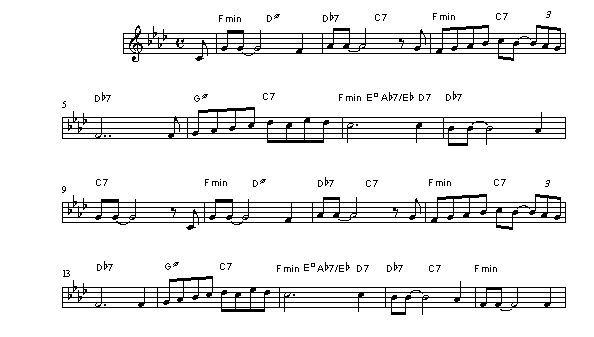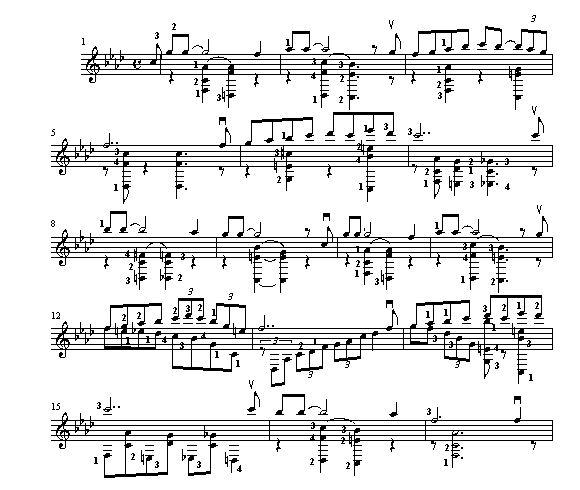|
Arranging a
Lead Sheet Melody
Besides playing music especially written for the concertina, it is of course
also possible to adapt any
piece of music for the instrument. Arranging music
for the concertina requires solid knowledge of
harmony, voicing and the
character of the concertina. Unfortunately many arrangements that have
been
published show very little knowledge of both music theory and the possibilities
of the
instrument.
Lead Sheet notation
The following example consist of the first 16 measures of the ballad "You
don't know what love is"
by G. de Paul. This form of music notation, a melody
line with chord symbols, is called a lead sheet,
and is the standard form of
music notation for all forms of popular music.

This ballad, in the key of F minor (4 flats), consist of a
simple melody with a constant harmonic
rhythm. The chords change about every two
beats. When you're going to arrange a melody like
this, you first should play
it through a few times, in order to get an idea of the character of the
song.
This ballad is rather slow, with an expressive melodic line. The expressive
character should
not be disrupted by the accompaniment you are going to add.
This means that you should give
the melody 'room' to be expressive.
How to determine the type of
accompaniment
When you examine the melody more closely, you'll see that most of the
rhythmical/melodic action
is on the first and 4th beat of the measure. The
second and third beat often consist of long notes.
When you combine these two
aspects, the accompaniment should be played on the 2nd and 3rd beat,
leaving the
melody enough 'room' on the 1st and 4th beat to be played expressively. If you
would play
an accompaniment on every beat, the melody would loose the necessary
freedom. Considering the
limited time available in each measure, an accompaniment consisting of block chords, rather than
arpeggios or a counter
melody, would be the most effective.
Chords on a Concertina
Playing chords on a concertina requires special attention. Close chords,
e.g. C-E-G, do not sound
good on a concertina (or any other free reed instrument
for that matter). The harmonics of the three
tones, being so close together, tend to clash. Chords sound a lot better when played in a wide position,
for
instance C-G-E. The spacing between the notes prevent the harmonics from
clashing.
Especially on instruments with metal ends close chords are a problem. Because
the metal ends create
a high sound reflection, overtones can become a serious
problem. On the other side of the spectrum,
brass reeded instruments suffer a
lot less from clashing overtones. On these instruments close chords
can sound
quite good. This fact becomes more relevant when playing Victorian concertina
music. In
19th century compositions, when brass reeded concertinas were the
standard, composers frequently
wrote large close chords. Also Victorian concertinas with steel reeds were suitable for close chords,
because of the
leather baffle, which muted the higher harmonics.
When arranging music for the concertina, either for treble, tenor-treble,
baritone or bass, pay
attention to the following points:
- The melody should be supported by the accompaniment, not distracted.
- The accompaniment has two functions: 1) providing harmony 2)
providing rhythm.
- When playing chords, keep them 'thin' and sporadic. It is not
necessary to play the
accompaniment on every beat. It should complement the
melody.
This arrangement, complete with fingering and bellows signs, is for
tenor-treble concertina. If you
compare this arrangement with the lead sheet,
you'll notice that the melody has been moved up one
octave. This will give you enough room under the melody for the chords. Listen to the sound file
below.

Necessary variation
The 16 measures of the example actually consist of a repeated 8 measure
melody. Repetition of a
melody is common, especially in popular music. When you
arrange such a piece, don't just repeat
the first melody. Repeated melodies
become boring very quickly. Do something different in the
repetition. You can
make small changes in the melody such as measure 12 in this example
(triplets
instead of 8th notes), or you can change the accompaniment.
In this example I exchanged the wide block chords I used in the first 8 measures
for a counter
melody (measures 12-14) with a poly-rhythmical element (two eight
notes against a triplet), and a
short 'bass-chord' pattern in measure 15.
To illustrate that such an arrangement sounds good on any
concertina, listen to this version of
"You don't know what love is" played on a
single action bass concertina with brass reeds, built
by Edward Chidley in the
1860s. The example below is exactly the same as the tenor-treble version,
only
notated in the bass clef.
Sound File See the Instrument

|


